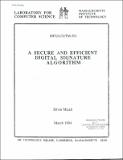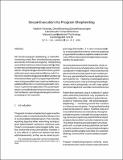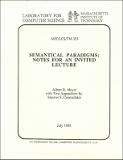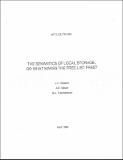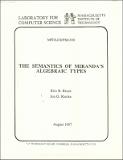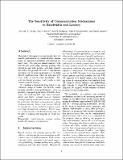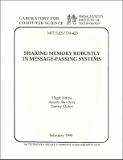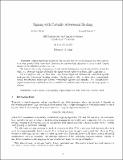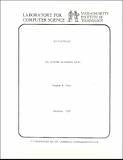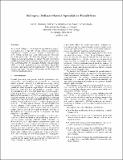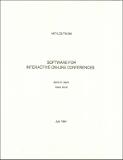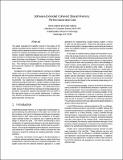Browsing LCS Technical Memos (1974 - 2003) by Title
Now showing items 395-414 of 492
-
Scalable Packet Classification Using Bit Vector Aggregating and Folding
(2003-04)Packet classification is a central function for a number of network applications, such as routing and firewalls. Most existing algorithms for packet classification scale poorly in either time or space when the database ... -
Secure Execution Via Program Shepherding
(2002-02)We introduce program shepherding, a method for monitoring control flow transfers during program execution to enforce a security policy. Shepherding ensures that malicious code masquerading as data is never executed, thwarting ... -
Semantical Paradigms: Notes for an Invited Lecture
(1988-07)It tooke me quite a few years to understand the point of the continuity in denotational semantics. I'm happy to report below on some recent results which justify my muddle-headedness and help to explain the point too. What ... -
The Semantics of Local Storage of What Makes The Free-list Free?
(1984-04)Denotational semantics for an ALGOL-like language with finite-mode procedures, blocks with local storage, and sharing (aliasing) is given by translating programs into an appropriately typed lambda-calculus. Procedures are ... -
The Semantics of Miranda's Algebraic Types
(1987-08)Miranda has two interesting features in its typing system: implicit polymorphism (also known as ML-style polymorphism) and algebraic types. Algebraic types create new types from old and can operate on arbitrary types. This ... -
Semaphore Primitives and Starvation-free Mutual Exclusion
(1980-03)Most discussions of semaphore primitives in the literature provide only an informal description of their behavior, rather than a more precissde definition. These informal descriptions may be incorrect, incomplete, or subject ... -
The Sensitivity of Communication Mechanisms to Bandwidth and Latency
The goal of this paper is to gain insight into the relative performance of communication mechanisms as bisection bandwidth and network latency vary. We compare shared memory with and without prefetching, message passing ... -
Signing with Partially Adversarial Hashing
(1998-02)Digital signatures usually utilize one-way hash functions designed by other parties. It is thus possible that such hash functions are adverserially designed so as to enable forging signatures in otherwise secure schemes. ... -
SIM360: A S/360 Simulator
(1972-05)Modern, large-scale computer systems typically operate under the control of an operating system or executive program, and reserve for the exclusive use of the operating system a set of privileged instructions, which the ... -
A Simple and Efficient Randomized Byzantine Agreement Algorithm
(1984-08)A new randomized Byantine agreement algorithm is presented. This algorithm operates in a synchronous systems of n processors, at most t of which can fail. The algorithm reaches agreement in O(t/log n) expected rounds and ... -
Simulation Techniques for Proving Properties of Real-time Systems
(1993-11)The method of simulations is an important technique for reasoning about real-time and other timing-based systems. It is adapted from an analogous method for untimed systems. This paper presents the simulation method in the ... -
Six Lectures on Dynamic Logic
(1978-12)The distinction made there between static and dynamic logic has a very simple character, yet can play a central and unifying role in logic as a vantage point from which one can compare propositional calculus, predicate ... -
Softspec: Software-based Speculative Parallelism
(2000-04)We present Softspec, a technique for parallelizing sequential applications using only simple software mechanisms, requiring no complex program analysis or hardware support. Softspec parallelizes loops whose memory references ... -
Software for Interactive On-line Conferences
(1984-07)A layered architecture for the implementation of real-time conferences is presented. In a real-time conference a group of users, each at his or her own workstation, share identical views of on-line application information. ... -
Software for the "Roles" People Play
(1983-02)Office work consists largely of cooperative efforts by numbers of people. To support such work, applications programs can be designed as "multi-person" systems organized around notions of "roles" and "working relationships." ... -
A Software Framework for Supporting General Purpose Applications on RAW Computation Fabrics
(2001-07)This paper presents SUDS (Software Un-Do Systems), a data speculation system for Raw processors. SUDS manages specultation in software. Thekey to managing speculation in software is to use the compiler to minimize the ... -
Software-Extended Coherent Shared Memory: Performance and Cost
(1993-10)This paper evaluates the tradeoffs involved when designing a directory-based protocol that implements coherent shared memory through a combination of hardware and software mechanisms. The fundamental design decisions involve ... -
Some New Methods of Music Synthesis
(1980-08)There are two distinct sections to this thesis. The first section discusses music composition, shows why it is a useful domain for Artificial Intelligence research and presents a set of "Design Rules" that facilitate ...


